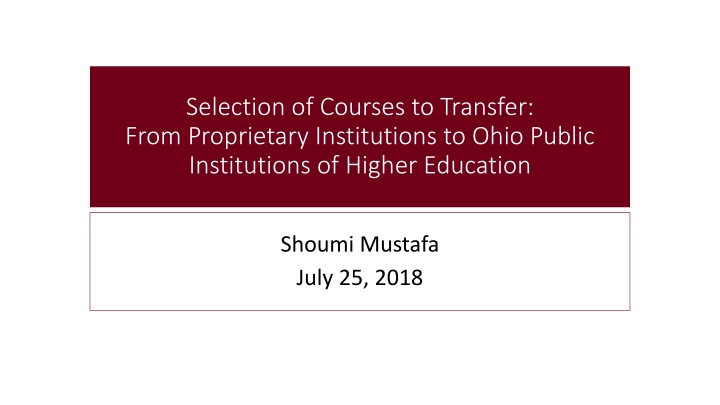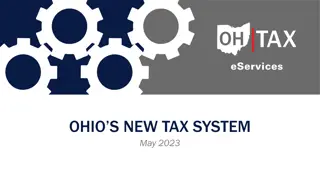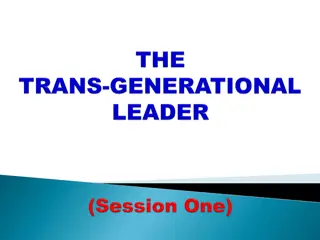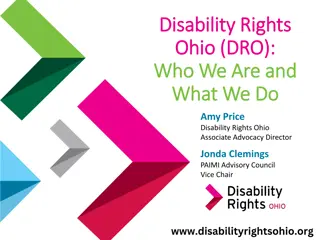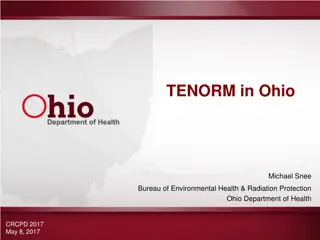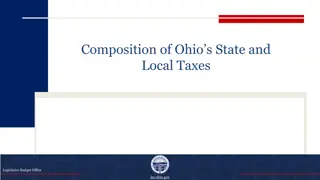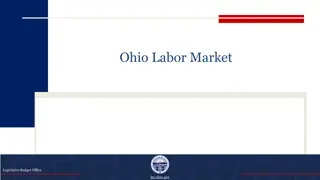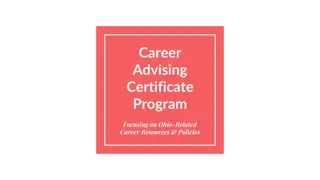Selecting Transferable Gen Ed Courses for Ohio Public Institutions
Stakeholders preparing the Transferability Strategic Plan in Ohio emphasize the importance of selecting transferable General Education courses from proprietary to public institutions. This involves identifying widely taken Gen Ed courses and using enrollment data from Ohio public institutions to determine the most beneficial courses for student transfers. Data on course enrollment numbers, transfer rates, and overall trends are obtained from various sources to inform the selection process.
Download Presentation

Please find below an Image/Link to download the presentation.
The content on the website is provided AS IS for your information and personal use only. It may not be sold, licensed, or shared on other websites without obtaining consent from the author.If you encounter any issues during the download, it is possible that the publisher has removed the file from their server.
You are allowed to download the files provided on this website for personal or commercial use, subject to the condition that they are used lawfully. All files are the property of their respective owners.
The content on the website is provided AS IS for your information and personal use only. It may not be sold, licensed, or shared on other websites without obtaining consent from the author.
E N D
Presentation Transcript
Selection of Courses to Transfer: From Proprietary Institutions to Ohio Public Institutions of Higher Education Shoumi Mustafa July 25, 2018
Selection of transferable courses: From proprietary to Ohio public institutions 1. Stakeholders assisting the preparation of the Transferability Strategic Plan (TSP) have identified the selection of transferable courses as a key issue. 2. There is a consensus among them that General Education (Gen.Ed.) coursework is likely to be the appropriate focus in the beginning: 3. Question: Which Gen.Ed. courses are to be selected? Courses with the highest rates of enrollment and transfer rates. This report presents a list of such courses, and provides a description of the selection process. In addition, the report provides a brief background on enrollment numbers and transfer trends of proprietary college students in Ohio. 2
How to select popular Gen.Ed. courses for the list of transferrable courses? 1. In the ideal word, the task involves the identification of Gen.Ed. courses commonly taken by students at proprietary institutions before they transfer to Ohio public institutions. 2. In reality, we do not have the information on enrollment numbers of pre- transfer Gen.Ed. courses taken by students at proprietary institutions; also, although we have information on their post-transfer courses at Ohio public institutions, the post-transfer samples are typically small and non- representative. 3. What do we do? We use information on course enrollment numbers for students attending Ohio public institutions of higher education. 3
Using enrollment data at Ohio public institutions Step 1: Identification of Gen.Ed. courses most commonly taken by students at Ohio public institutions of higher education. Step 2: The ranking of courses by enrollment numbers gives a clear indication regarding which Gen.Ed. Courses, if transferred, will help transfer students the most in their pursuit of degree attainments without undue course duplication. However, HEI does not identify Gen.Ed. courses directly. Instead, it provides the following definition for General Studies: . . . . . courses which are general, introductory, or core courses. Courses which satisfy distributive requirements, the set of courses which provide students with a broad knowledge base, generally in the humanities, natural sciences and social sciences, for an associate or baccalaureate degree should be assigned to the General Studies level. From https://www.ohiohighered.org/node/1860#courselevel. 4
Data Course enrollment numbers and rates are obtained from the Higher Education Information (HEI) system of the Ohio Department of Higher Education. Information on proprietary to Ohio public institution transfers are obtained from the HEI and the National Student Clearinghouse (NSC) data. Overall enrollment trends are obtained from Enrollment Surveys of the Integrated Postsecondary Education Data Systems (IPEDS) of the U.S. Department of Education. 5
A brief background: Enrollment and transfer numbers Undergraduate enrollment numbers between 2007-08 and 2015-16: Ohio public institutions Proprietary institutions in Ohio Transfer movements from proprietary institutions in Ohio to Ohio public institutions. 6
Enrollment trends: Proprietary and Ohio public institutions Enrollment in Ohio Public Institutions Enrollment in Proprietary Institutions in Ohio 700,000 120,000 649,618 638,500 619,075 607,607 606,760 591,195 587,477 600,000 97,349 565,545 100,000 540,738 88,993 500,000 80,508 77,521 80,000 67,316 66,071 400,000 57,790 60,000 51,795 300,000 39,335 40,000 200,000 20,000 100,000 0 0 2008 2009 2010 2011 2012 2013 2014 2015 2016 2008 2009 2010 2011 2012 2013 2014 2015 2016 Note: Enrollment numbers obtained from IPEDS. 7
Transfer movements by year: Proprietary institutions to Ohio public institutions From Proprietary Institutions to Ohio Public Institutions 1,400 1,312 1,200 1,120 1,076 1,030 959 1,000 800 751 685 600 400 284 233 200 76 64 31 29 26 14 8 3 2 0 0 0 0 1996-97 1997-98 1998-99 1999-00 2000-01 2001-02 2002-03 2003-04 2004-05 2005-06 2006-07 2007-08 2008-09 2009-10 2010-11 2011-12 2012-13 2013-14 2014-15 2015-16 2016-17 Note: Transfer numbers obtained from HEI and NSC data. 8
Popular Gen.Ed. courses at Ohio public institutions How do we present the data? First, we provide a list of the 20 most popular subjects at Ohio public institutions in 2016-17, along with enrollment counts for each subject. The classification of subjects follows the scheme given by the Integrated Postsecondary Education System (IPEDS). Second, for each of the 20 popular subjects, we provide separate lists of Gen.Ed. course titles, along with their respective shares. Third, we provide a list of popular Gen.Ed. Course titles, along with their enrollment numbers. 9
Popular Gen.Ed. courses at Ohio public institutions Results: English Composition I was by far the most common Gen.Ed. course at Ohio public institutions in 2016-17; the course was attempted 66,753 times. Introduction to Sociology was the second most common course while English Composition II was the third most common course on the list; Sociology and English Composition II were attempted 38,844 and 32,724 times, respectively. English Composition I and II were taught under two different subjects: the majority was under Writing, General, and a smaller number was under English Language and Literature. 10
The 20 most common subjects: Ohio public institutions SL. Subject Title (CIP*) #Enrollment SL. Subject Title (CIP*) #Enrollment 1 Writing, General 119,887 11 Rhetoric and Composition 24,934 2 Mathematics, General 69,723 12 Registered Nursing/Nurse 24,409 3 Psychology, General 68,984 13 Business Adm. & Management, General 24,117 4 Chemistry, General 58,546 14 English Language and Literature, General 22,325 5 Sociology 55,972 15 Philosophy 21,845 6 Economics, General 51,267 16 History, General 21,828 7 Biology/Bio., General 44,727 17 Spanish Language and Literature 19,207 8 Speech Communication and Rhetoric 29,674 18 Music History, Literature, and Theory 17,979 9 Statistics, General 28,327 19 Anatomy 17,291 10 Geology/Earth Science, General 25,609 20 Physics, General 16,279 *CIP: Classification of Instructional Programs. 11
Common Gen.Ed. courses: First to fifth most popular subjects Subject Title (CIP*) Course Titles (Proportions within the subject in parentheses) #Enrollment English Composition I (50.0%)* English Composition II (24.8%)* Writing, General 119,887 College Algebra (34.0%) Pre-Calculus (14.0%) Trigonometry (7.4%) Quantitative Reasoning (4.3%) Mathematics, General 69,723 Introduction to Psychology (46.1%) General Psychology (45.3%) Principles of Psychology (3.5%) Psychology, General 68,984 Chemistry I (43.7%) Chemistry II (15.6%) Chemistry, General 58,546 Introduction to Sociology (69.4%) Principles of Sociology (5.3%) Sociology 55,972 * Course titles English Composition I and English Composition II are included under CIP subject title Writing, General and also under English Language and Literature, General . 12
Common Gen.Ed. courses: Sixth to 10th popular subjects Subject Title (CIP*) Course Titles (Proportions within the subject in parentheses) #Enrollment Principles of Microeconomics (51.3%) Principles of Macroeconomics (36.3%) Economics, General 51,267 Biology/Biological Sciences, General Biology I (17.6%) Human Biology (11.1%) Biology II (7.3%) 44,727 Fundamental of Human Communication (15.9%) Introduction to Human Communication (15.1) Speech Communication and Rhetoric Introduction to Public Speaking (13.3%) Public Speaking (13.3%) 29,674 Elementary Statistics (32.7%) Introduction to Statistics (30.8%) Introduction to Statistics (12.8%) Statistics, General 28,327 How the Earth Works (9.5%) Geology/Earth Science, General The Dynamic Earth (12.8%) Physical Geology (7.7%) Earth Science (5.8%) 25,609 13
Common Gen.Ed. courses: 11th to 15th popular subjects Subject Title (CIP*) Course Titles (Proportions within the subject in parentheses) #Enrollment Fundamentals of Speech Communications (6.4%) English Composition (15.0%) College Composition I (12.5%) Rhetoric and Composition Intr. to Public Speaking (10.6%) 24,934 Registered Nursing/Registered Nurse Business Administration and Management, General Too many different courses: 274 in total. Top five courses account for only 8.6% of the courses: Community/Home Nursing, Dosage Calculation, Foundations of Nursing, Health Assessments, Health Deviations. 24,409 Introduction to Business (9.8%) Principles of Management (9.3%) Business Survey (7.2%) Management (4.8%) 24,117 English Composition I (30.5%)* Intro. to Philosophy (38.9%) English Composition II (13.4%)* English Language and Literature, General Composition and Rhetoric (15.2%) English I (10.9%) English II (7.1%) 22,325 Ethics (13.1%) Introduction to Ethics (5.4%) Critical Thinking (4.6%) Philosophy 21,845 14
Common Gen.Ed. courses: 16th to 20th popular subjects Subject Title (CIP*) Course Titles (Proportions within the subject in parentheses) #Enrollment Western Civilization I (6.7%) Elementary Spanish I (18.1%) Music as a World Phenomenon (14.3%) Anatomy and Physiology I (42.1%) World History Ancient and Medieval (6.4%)) Elementary Spanish II (12.3%) Western Civilizations to 1500 (5.5%) World History to 1500 (5.5%) History, General 21,828 Spanish Language and Literature Beginning Spanish I (9.9%) Spanish II (8.3%), Spanish I (5.5%) 19,207 Music History, Literature, and Theory The Understanding of Music (9.3%) History of Rock Music I (8.6%) Exploring Musical Styles (7.3%) 17,979 Anatomy and Physiology II (25.2%) Foundational Anatomy and Physiology (4.4%) Fundamentals of Anatomy and Physiology (2.5%) Anatomy 17,291 General Physics II (6.1%) General College Physics I (5.8%) Algebra-based Physics I (4.0%) College Physics I (3.9%) Physics, General 16,279 * Course titles English Composition I and English Composition II are included under CIP subject title Writing, General and also under English Language and Literature, General . 15
Common Gen.Ed. courses by course title Group: 1 to 5 Group: 6 to 10 Group: 11 to 15 Group: 16 to 20 Course Title Number Course Title Number Course Title Number Course Title Number English Composition I Principles of Microeconomics Elementary Statistics Anatomy and Physiology I 66,753 26,300 9,263 7,280 Introduction to Sociology 38,845 Chemistry I 25,585 Chemistry II 9,133 Human Biology 4,965 Fundamental of Human Communication Introduction to Human Communication English Composition II Introduction to Statistics 32,724 College Algebra 23,706 8,725 4,718 Introduction to Psychology Principles of Macroeconomics Introduction to Philosophy 31,802 18,610 8,498 4,481 General Psychology Anatomy and Physiology II 31,250 Pre-Calculus 9,761 Biology I 7,872 4,357 16
Summary This report identifies common Gen.Ed. courses at Ohio public institutions; the effort is crucial to stakeholders planning the Transferability Strategic Plan (TSP). The report presents information on the popular courses, and also classifies them under their respective subjects. English Composition I, Introduction to Sociology, and English Composition II are found to be the top three Gen.Ed. courses. 17
